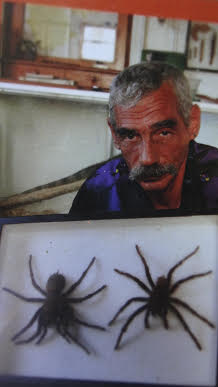Stridulation is the act of producing sound by rubbing together certain body parts. This behavior is mostly associated with insects, but other animals are known to do this as well, such as a number of species of fish, snakes and spiders. The mechanism is typically that of one structure with a well-defined lip, ridge, or nodules being moved across a finely-ridged surface or vice versa, and vibrating as it does so, like the dragging of a phonograph needle across a vinyl record. Sometimes it is the structure bearing the file which resonates to produce the sound, but in other cases it is the structure bearing the scraper, with both variants possible in related groups. Common onomatopoeic words for the sounds produced by stridulation include chirp and chirrup.

Huntsman spiders, members of the family Sparassidae, are known by this name because of their speed and mode of hunting. They catch their prey by hunting rather than in webs. They are also called giant crab spiders because of their size and appearance. Larger species sometimes are referred to as wood spiders, because of their preference for woody places. In southern Africa the genus Palystes are known as rain spiders or lizard-eating spiders. Commonly, they are confused with baboon spiders from the Mygalomorphae infraorder, which are not closely related.

The Goliath birdeater belongs to the tarantula family Theraphosidae. Found in northern South America, it is the largest spider in the world by mass and body length, and second to the giant huntsman spider by leg span. It is also called the Goliath tarantula or Goliath bird-eating spider; the practice of calling theraphosids "bird-eating" derives from an early 18th-century copper engraving by Maria Sibylla Merian that shows one eating a hummingbird. Despite the spider's name, it rarely preys on birds.

Selenocosmia crassipes, synonym Phlogius crassipes, also known as the "Queensland whistling tarantula", "barking spider" or "bird-eating tarantula" is a species of tarantula native to the east coast of Queensland, Australia. The name "whistling tarantula" comes from its ability to produce a hissing noise when provoked, a trait it shares with other Australian theraphosids. This hissing is produced by the spider stridulating a patch of setae associated with its chelicerae. It has also been called the "eastern tarantula". The species name crassipes is Latin for "fat leg" referring to the relatively fat front legs.

Barychelidae, also known as brushed trapdoor spiders, is a spider family with about 300 species in 39 genera.

Annandaliella travancorica is a species of tarantula spider found in the Western Ghats of India. It was the first of three members of the genus Annandaliella to be described, therefore the type species.

Selenocosmia is a genus of tarantulas that was first described by Anton Ausserer in 1871. The genus is found in China, New Guinea, Australia, Indonesia, Myanmar, Malaysia, Laos, Vietnam, Philippines, India and Pakistan. They are commonly referred to as whistling or barking spiders, due to their ability to stridulate using lyra hairs.

Annandaliella is a genus of tarantulas that was first described by A. S. Hirst in 1909. As of December 2019 it contains three species endemic to India: A. ernakulamensis, A. pectinifera, and A. travancorica. They are selenogyrid tarantulas, meaning they have a stridulating organ on the inner side of the chelicerae.

Poecilotheria metallica, also known as the peacock tarantula, is an Old World species of tarantula. It is the only blue species of the genus Poecilotheria. Like others in its genus it exhibits an intricate fractal-like pattern on the abdomen. The species' natural habitat is deciduous forest in Andhra Pradesh, in central southern India. It has been classified as Critically endangered by the IUCN.

Tarantulas comprise a group of large and often hairy spiders of the family Theraphosidae. As of December 2023, 1,100 species have been identified, with 166 genera. The term "tarantula" is usually used to describe members of the family Theraphosidae, although many other members of the same infraorder (Mygalomorphae) are commonly referred to as "tarantulas" or "false tarantulas". Some of the more common species have become popular in the exotic pet trade. Many New World species kept as pets have setae known as urticating hairs that can cause irritation to the skin, and in extreme cases, cause damage to the eyes.

Theraphosa apophysis is a species of spider in the family Theraphosidae, found in Venezuela, Colombia and Brazil.

Aphonopelma anax, commonly known as the Texas tan tarantula, is a species of spider belonging to the family Theraphosidae native to southern Texas and northern Mexico.

The Stromatopelminae are a subfamily of tarantulas native to West Africa and part of Central Africa. The subfamily was first proposed by Günter Schmidt in 1993.

Cyriopagopus is a genus of southeast Asian tarantulas found from Myanmar to the Philippines. As of March 2017, the genus includes species formerly placed in Haplopelma. It was first described by Eugène Louis Simon in 1887.
The Selenogyrinae are a subfamily of tarantulas found in Africa and Asia.
Euphrictus is a genus of tarantula which is found in Africa. It is part of the subfamily Selenogyrinae.
Euphrictus squamosus is a tarantula in the Selenogyrinae subfamily. It is native to the Congo.

Theraphosa stirmi is a species of tarantula belonging to the family Theraphosidae. It is known as the burgundy goliath bird eater.

Chilobrachys is a genus of Asian tarantulas that was first described by Ferdinand Anton Franz Karsch in 1892. They are found in India, Myanmar, Malaysia, China, Vietnam, Thailand and Sri Lanka. They are usually medium or large-sized, and they can stridulate by using small spines present on the chelicerae.

Phlogiellus is a genus of tarantulas that was first described by Reginald Innes Pocock in 1897. They are found throughout Asia and Papua New Guinea, including Indonesia, the Philippines, Papua New Guinea, China, Myanmar, Malaysia, Borneo, Thailand, the Solomon Islands and Taiwan. Phlogiellus is part Latin and part Greek, the first part being "φλóξ φλoγóϛ", meaning flame, the second part being "ellus" which is a latin diminutive suffix.














